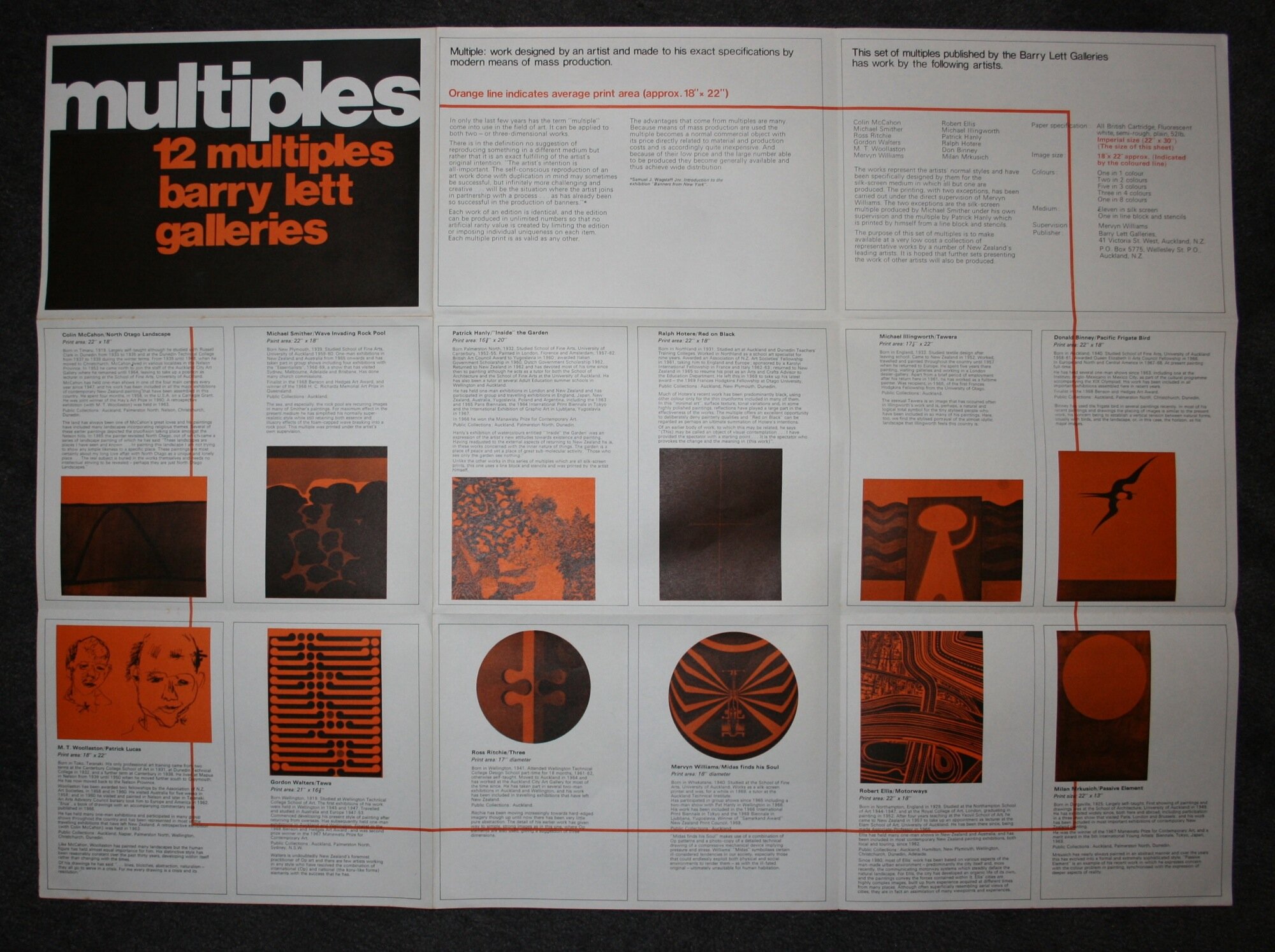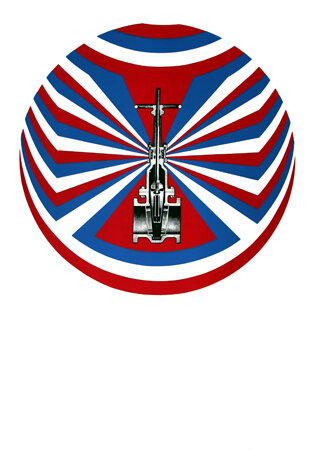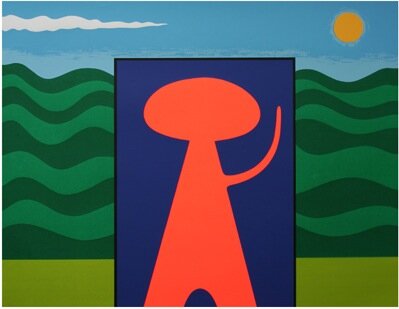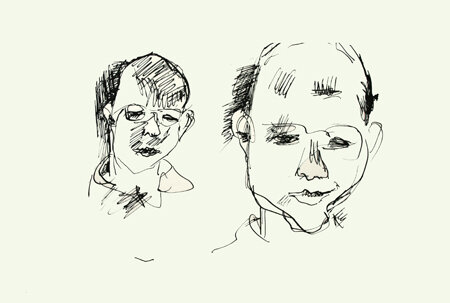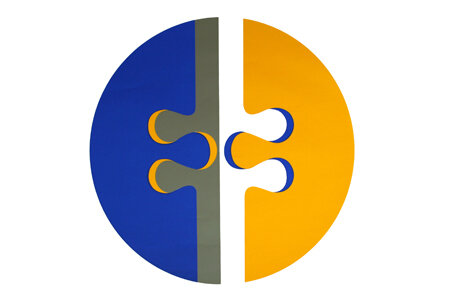Barry Lett Multiples
Rare NZ Artworks on Paper
1968: seen as a collection, the vision of the group who pulled this together can be appreciated.
The Barry Lett Multiples are a set of 12 prints on paper sold in New Zealand in 1968.
Auckland art dealer Barry Lett produced the set with the idea of making modern art accessible to a wider audience by at a low cost - especially the education market. He invited 12 artists, some established, and some up and coming, to contribute to the project. They were printed on paper (mostly screen-printed), and came stacked in a single glass-fronted wooden frame so that they could be rotated for viewing at will.
Several of the artists were captured by the ‘Op-Art’ movement of the late 1960s - optical illusions within the work.
Many of the 12 who contributed have emerged as significant New Zealand artists - most notably Colin McCahon, Gordon Walters, Ralph Hotere and Milan Mrkusich.
In 1968 the price $35 for the full set and it is unknown exactly how may copies were produced.
The exhibition catalogue is a sheet of large (A1-ish size) paper, printed in 2 colours with an explanatory piece about each artist and their print, and shows (with an orange line) the size of the main prints.
The sets usually became split as the more widely known artist’s prints, especially those by Colin McCahon, Gordon Walters and Ralph Hotere were more sought after. Many a McCahon or Binney was to be seen in the foyer of an Auckland advertising agency in the 1990s. There are therefore relatively few complete sets. Iconic individual works like McCahon and Binney have since been seen to change hands between $3,000 and $6,000 each.
Commentaries below are taken from the original gallery catalogue, so may seem a bit out of sorts at times!
In many ways, the catalog is a work of art on its own.
Don Binney, Pacific Frigate Bird
Born in Auckland, 1940. Studied School of Fine Arts, University of Auckland 1958-61. Awarded Queen Elizabeth II Arts Council Fellowship in 1966.
In Europe and North and Central America in 1967-68. At present painting full-time.
He has held several one-man shows since 1963, including one at the Instituto Anglo-Mexicano in Mexico City, as part of the cultural programme accompanying the XIX Olympiad. His work has been included in all important exhibitions assembled here in recent years.
Finalist in the 1968 Benson and Hedges Art Award.
Public Collections: Auckland, Palmerston North, Christchurch, Dunedin.
Binney has used the frigate bird in several paintings recently In most of his recent paintings and drawings the placing of images is similar to the present work, his concern being to establish a vertical tension between natural forms, usually with birds, and the landscape, or, in this case, the horizon, as his major Images.
Gordon Walters, Tawa
Born Wellington, 1919. Studied at Wellington Technical College School of Art. The first exhibitions of his work were held in Wellington in 1945 and 1947. Traveled and studied in Australia and Europe 1947-53. Commenced developing his present style of painting after returning from overseas. Has subsequently held one-man exhibitions in Auckland and Wellington. Finalist in the 1968 Benson and Hedges Art Award, and was second prize winner in the 1967 Manawatu Prize for Contemporary Art.
Public Collections: Auckland, Palmerston North, Sydney, N.S.W.
Walters is undoubtedly New Zealand's foremost practitioner of Op art and there are few artists working in any style who have resolved the combination of international (Op) and national (the koru-like forms) elements with the success that he has.
Robert Ellis, Motorways
Born in Northampton, England in 1929. Studied at the Northampton School of Art 1944-1947, and at the Royal College of Art London, graduating in painting in 1952. After four years teaching at the Yeovil School of Art he came to New Zealand in 1957 to take up an appointment as lecturer at the Elam School of Art University of Auckland. He has been there since, being made Associate Professor in 1966. Ellis has held many one-man shows in New Zealand and Australia, and has been included in most contemporary New Zealand painting exhibitions, both local and touring, since 1962.
Public Collections: Auckland, Hamilton, New Plymouth, Wellington, Christchurch, Dunedin, Adelaide.
Since 1960, most of Ellis' work has been based on various aspects of the man-made urban environment - predominantly the city itself and, more recently, the communicating motorway systems which steadily deface the natural landscape. For Ellis, the city has developed an organic life of its own, and the paintings convey the forces contained within it. Ellis' cities are highly complex images, built up from experience acquired at different times from many places. Although often superficially resembling aerial views of cities, they are in fact an assimilation of many viewpoints and experiences.
Mervyn Williams, Midas finds his Soul
Born in Whakatane, 1940. Studied at the School of Fine Arts, University of Auckland. Works as a silk-screen printer and was, for a while In 1969, a tutor at the Auckland Technical Institute. Has participated in group shows since 1965 including a two-man show with Pat Hanly in Wellington in 1966.
His work has been included in the 1966 International Print Biennale in Tokyo and the 1969 Biennale in Ljubljana, Yugoslavia. Winner of "Samarkand Award" New Zealand Print Council, 1969 .
Public Collections: Auckland.
Midas finds his Soul makes use of a combination of Op Art patterns and a photo-copy of a detailed technical drawing of a compressive mechanical device implying pressure and stress. Williams' Midas symbolises certain ill-considered tendencies in our society, especially those that could endlessly exploit both physical and social environments to render them - as with the ill-fated original - ultimately unsuitable for human habitation.
Ralph Hotere, Red on Black
Born in Northland in 1931. Studied art at Auckland and Dunedin Teachers' Training Colleges. Worked in Northland as a school art specialist for nine years. Awarded an Association of N.Z. Art Societies' Fellowship in 1961, taking him to England and Europe; sponsored by a Karolyi International Fellowship in France and Italy 1962-63; returned to New Zealand in 1965 to resume his post as an Arts and Crafts Advisor to the Education Department. He left this in 1969 to take up his latest award - the 1969 Frances Hodgkins Fellowship at Otago University.
Public Collections: Auckland, New Plymouth, Dunedin.
Much of Hotere's recent work has been predominantly black, using other colour only for the thin cruciforms included in many of them.
In this "minimal art", surface texture, tonal variations and, in some highly polished paintings, reflections have played a large part in the effectiveness of the works. The multiple offers an excellent opportunity to deliberately deny painterly qualities and "Red on Black" can be regarded as perhaps an ultimate summation of Hotere's intentions.
Of an earlier body of work, to which this may be related, he says "(This) may be called an object of visual contemplation ... I have provided the spectator with a starting point ... It is the spectator who provokes the change and the meaning in (this work) ".
Michael Smither, Wave Invading Rockpool
Born New Plymouth, 1939. Studied School of Fine Arts, University of Auckland 1959-60. One-man exhibitions in New Zealand and Australia from 1965 onwards and has taken part in group shows including four exhibitions with the "Essentialists", 1968-69, a show that has visited Sydney, Melbourne, Adelaide and Brisbane. Has done many church commissions.
Finalist in the 1968 Benson and Hedges Art Award, and winner of the 1968 H. C. Richards Memorial Art Prize in Queensland.
Public Collections: Auckland.
The sea, and especially, the rock pool are recurring images in many of Smither's paintings. For maximum effect in the present medium he has simplified his normally super-realistic style while still retaining both essence and illusory effects of the foam-capped wave breaking into a rock pool. This multiple was printed under the artist's own supervision.
Patrick Hanly, Inside the Garden
Born Palmerston North, 1932. Studied School of Fine Arts, University of Canterbury, 1952-55. Painted in London, Florence and Amsterdam, 1957 -62, British Art Council Award to Yugoslavia in 1960; awarded Italian Government Scholarship in 1960, Dutch Government Scholarship 1962.
Returned to New Zealand in 1962 and has devoted most of his time since then to painting although he acts as a tutor for both the School of Architecture and the School of Fine Arts at the University of Auckland. He has also been a tutor at several Adult Education summer schools in Wellington and Auckland.
He has held one-man exhibitions in London and New Zealand and has participated in group and travelling exhibitions in England, Japan, New Zealand, Australia, Yugoslavia, Poland and Argentina, including the 1963 and 1965 Paris Biennales, the 1964 International Print Biennale in Tokyo and the International Exhibition of Graphic Art in Ljubljana, Yugoslavia in 1967.
In 1966 he won the Manawatu Prize for Contemporary Art.
Public Collections: Auckland, Palmerston North, Dunedin.
Hanly's exhibition of watercolours entitled 'Inside the Garden' was an expression of the artist's new attitudes towards existence and painting. Having readjusted to the external aspects of returning to New Zealand he is, in these works concerned with the inner nature of things. The garden is a place of peace and yet a place of great sub-molecular activity. "Those who see only the garden see nothing."
Unlike the other works in this series of multiples which are all silk-screen prints, this one uses a line block and stencils and was printed by the artist.
Colin McCahon, North Otago Landscape
Born in Timaru, 1919. Largely self·taught although he studied with Russell Clark in Dunedin from 1933 to 1935 and at the Dunedin Technical College 1937 to 1939 during the winter terms. From 1939 until 1948, when he moved to Christchurch, McCahon lived in various localities in the Nelson province. In 1953 he came North to join the staff of the Auckland City Art Gallery where he remained until 1964, leaving to take up a position as lecturer in painting at the School of Fine Arts, University of Auckland.
McCahan has held one man shows in one of the four main centres every year since 1947, and his work has been included in all the major exhibitions of contemporary New Zealand painting that have been assembled in this country. He spent four months, in 1958, in the U.S.A. on a Carnegie Grant. He was joint winner of the Hay's Art Prize in 1960. A retrospective exhibition (with M. T. Woollaston) was held in 1963.
Collections: Auckland, Palmerston North, Nelson, Christchurch, Dunedin.
The land has always been one of McCahon's great loves and his paintings have included many landscapes incorporating religious themes. Several of earlier paintings depicted the crucifixion taking place amongst the Nelson hills. In 1965 the painter revisited North Otago, out of which. came a series of landscape painting of which he has said:
"These landscapes are places I have seen and known ... in painting this landscape I am not trying to show any simple likeness to a specific place. These paintings are most certainly about my long love affair with North Otago as a unique and lonely place. The real subject is buried in the works themselves and needs no intellectual striving to be revealed - perhaps they are just North Otago Landscapes."
Michael Illingworth, Tawera
Born in England, 1932. Studied textile design after leaving school. Came to New Zealand in 1952. Worked, traveled and painted throughout the country until 1957 when he returned to Europe. He spent five years there painting, visiting galleries and working in a London dealer-gallery.
Apart from a brief period of employment after his return here in 1961, he has worked as a fulltime painter. Was recipient in 1966, of the first Frances Hodgkins Fellowship from the University of Otago.
Public Collections: Auckland.
The asexual Tawera is an image that has occurred often in Illingworth's work and is, perhaps, a natural and logical total symbol for the tiny stylised people who have been included in so many of his paintings. Here, too, we find the stylised portrayal of the almost idyllic landscape that Illingworth feels this country is.
Toss Woollaston, Patrick Lucas
Born in Toko, Taranaki. His only professional art training came from two terms at the Canterbury College School of Art in 1931, at Dunedin Technical College in 1932, and a further term at Canterbury in 1938. He lived at Mapua in Nelson from 1939 until 1950 when he moved further south to Greymouth. He has now moved back to the Nelson Province.
Woollaston has been awarded two fellowships by the Association of NZ Art Societies in 1958 and in 1960. He visited Australia for five weeks in 1958, and in 1960 he visited and painted in Nelson and later in Taranaki. An Arts Advisory Council bursary took him to Europe and America in 1962. "Erua" a book of drawings with an accompanying commentary was published in 1966.
He has held many one-man exhibitions and participated in many group shows throughout the country and has been represented in most of the travelling exhibitions that have left New Zealand. A retrospective exhibition (with Colin McCahon) was held in 1963.
Public Collections: Auckland, Napier, Palmerston North, Wellington, Christchurch, Dunedin.
Like McCahon, Woollaston has painted many landscapes but the human figure has held almost equal importance for him. H is distinctive style has been reasonably constant over the past thirty years. developing within itself rather than changing with the times. Of his drawings he has said " ... lines, blotches, abstraction, naturalism they all go to serve in a crisis. For me every drawing is a crisis and its resolution."
Ross Ritchie, Three
Born in Wellington, 1941. Attended Wellington Technical College Design School part-time for 18 months, 1961 -62, otherwise self-taught. Moved to Auckland in 1964 and has worked at the Auckland City Art Gallery for most of the time since.
He has taken part in several two-man exhibitions in Auckland and Wellington, and his work has been included in travelling exhibitions that have left New Zealand.
Public Collections: Auckland.
Ritchie has been moving increasingly towards hard-edged imagery though up until now there has been very little pure abstraction. The detail of his earlier work has given way to strong, simple images as in this one, where Op elements are also used, giving the suggestion of 3 dimensions.
Milan Mrkusich, Passive Element
Born in Dargaville, 1925. largely self-taught. First showing of paintings and drawings was at the School of Architecture, University of Auckland in 1949. He has exhibited widely since, both here and abroad, including participation in a three man show that visited Paris, London and Brussels; and his work has been included in most important exhibitions of contemporary New Zealand paintings.
Public Collections: Auckland, Palmerston North, Dunedin
Mrkusich has nearly always painted in an abstract manner' this has evolved into a formal and extremely sophisticated style. Passive Element is an example of his recent work in which he expresses his concern with the colour problem in painting, synchronised with the expression of the deeper aspects of reality.


